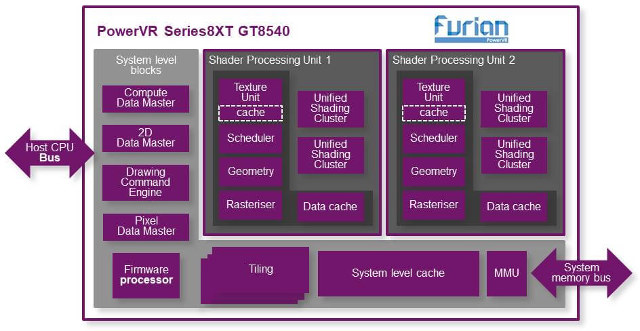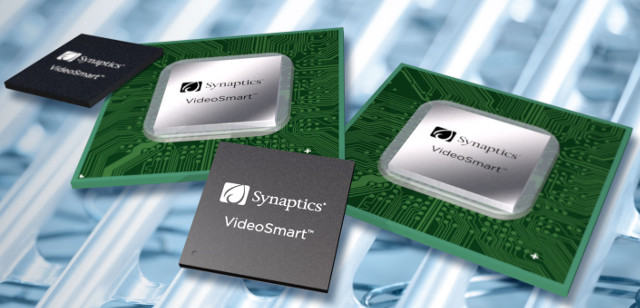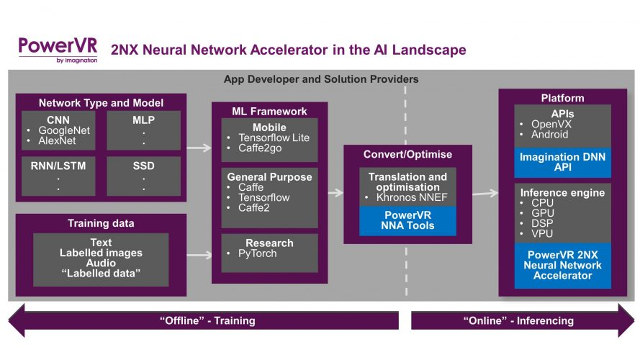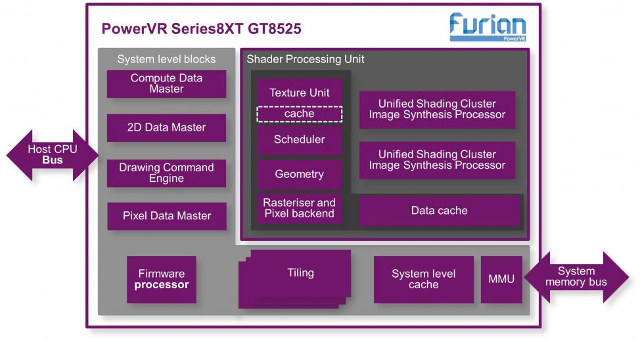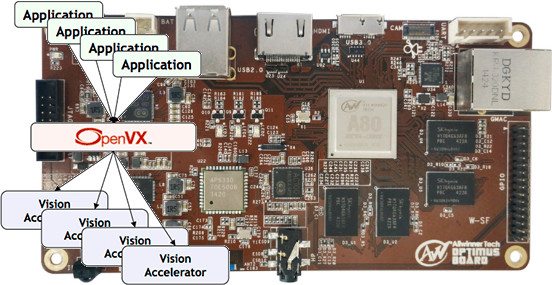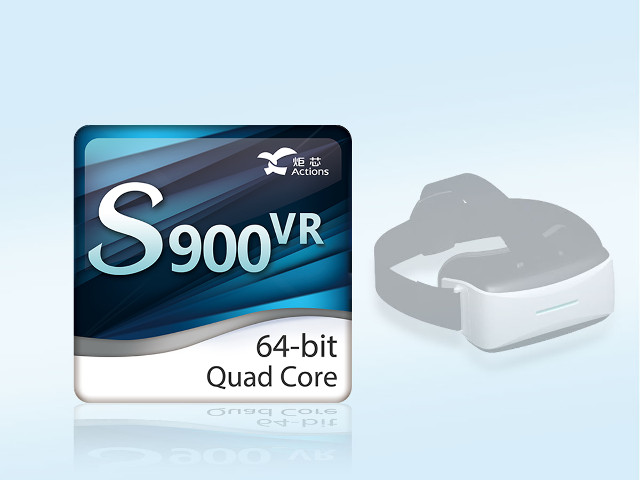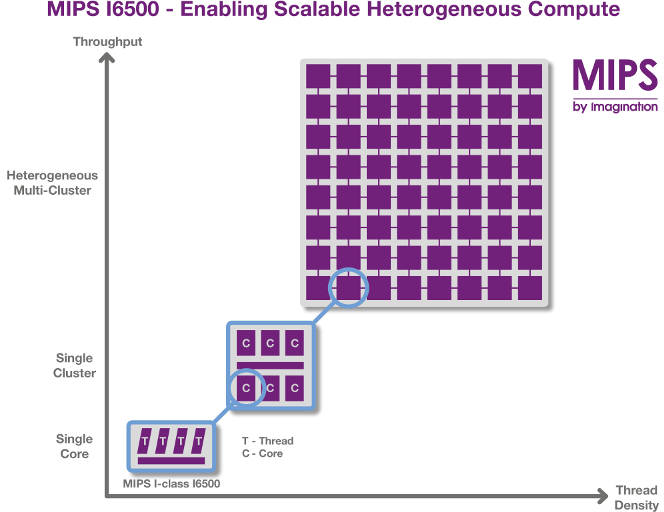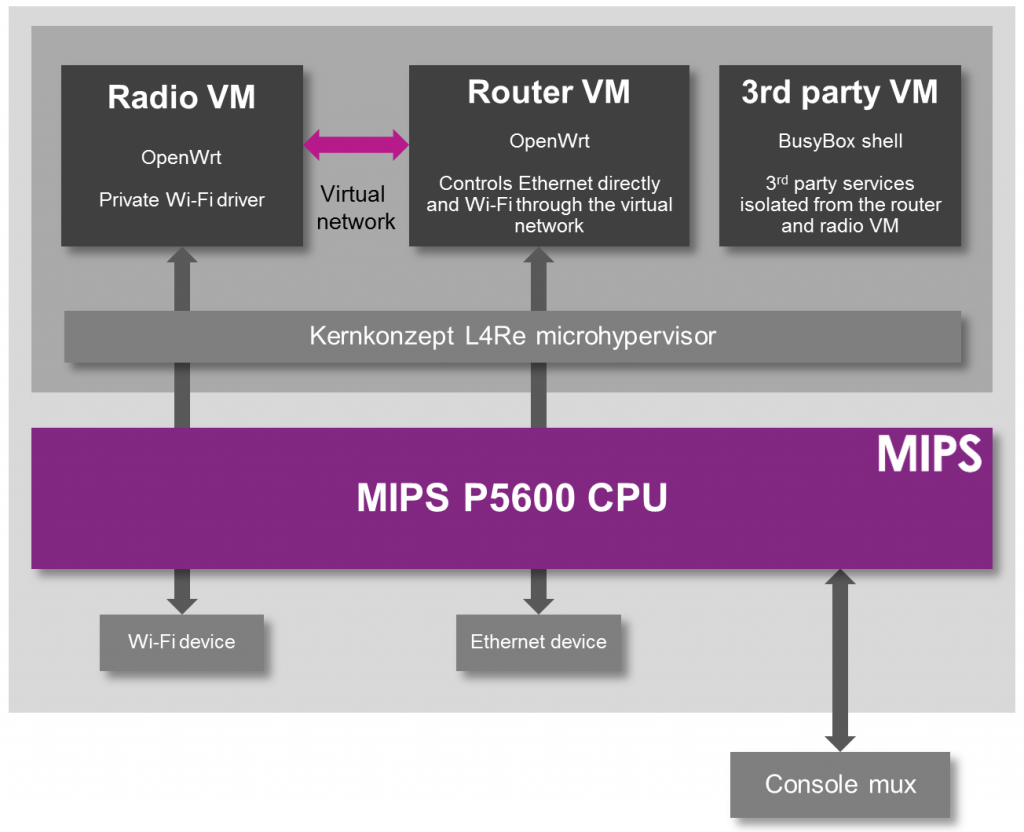Imagination Technologies introduces PowerVR Furian architecture last year with improved performance, power and density, as well as dual cluster PowerVR Series8XT GT8525 GPU based on the new architecture, and targeting high-end smartphones, virtual reality and automotive products. The company has now introduced a quad cluster Furian GPU called PowerVR Series8XT GT8540 that can simultaneously drive up to six 4K screens at 60fps thanks to an 80% fillrate density improvement, and supports virtualization providing separation of services and applications. The new GPU mostly targets the automotive market with some new cars now requiring multiple screen support with high resolution displays for cluster, Head-Up Display (HUD) and infotainment. Hardware virtualization is equally important for automotive application, as you’ll want to separate safety-critical code, from infotainment applications for example, so if the latter crashes, the safety-critical code can still run unhindered. Each would run on separate shaders processing unit, with up to 8 […]
Synaptics Introduces VideoSmart BG5CT 4K HDR Multimedia Video Processor for Set-Top Boxes
Marvell used to design Media SoCs running Android TV such as ARMADA 1500 Ultra (aka BG4CT). That part of Marvell business has very recently been sold to Synaptics, which has just unveiled VideoSmart BG5CT multimedia SoC with 4K “Advanced” HDR video processing for the set-top-box market. The BG5CT is said to be pin-to-pin compatible with BG4CT Android TV SoC, features a quad core ARM CPU @ 1.6 GHz with 15K DMIPS, an Imagination PowerVR Series8XE GE8310 GPU, and a security engine enabling secure boot, Trusted Rendering Path, full TrustZone, and video watermarking carrier-grade security making it suitable for Pay TV operators and set-top-box manufacturers. Synaptics’ Qdeo video processing technology adds 4K “Advanced HDR” – including HDR10, HLG, Dolby Vision, and Technicolor HDR, among user video processing technology. The company did not provide that many details, but BG5CT appears to mostly add HDR support compared to BG4CT, and replace Vivante GC7000 GPU by […]
Imagination Announces PowerVR Series2NX Neural Network Accelerator (NNA), and PowerVR Series9XE and 9XM GPUs
Imagination Technologies has just made two announcements: one for their PowerVR Series2NX neural network accelerator, and the other for the new high-end GPU families: PowerVR Series9XE and 9XM. PowerVR Series2NX neural network accelerator The companies claims 2NX can deliver twice the performance and half the bandwidth of nearest competitor, and it’s the first dedicated hardware solution with flexible bit-depth support from 16-bit down to 4-bit. Key benefits of their solution (based on market data available in August 2017 from a variety of sources) include: Highest inference/mW IP cores to deliver the lowest power consumption Highest inference/mm2 IP cores to enable the most cost-effective solutions Lowest bandwidth solution with support for fully flexible bit depth for weights and data including low bandwidth modes down to 4-bit 2048 MACs/cycle in a single core, with the ability to go to higher levels with multi core The PowerVR 2NX NNA is expected to be […]
Imagination PowerVR “Furian” Series8XT GT8525 GPU Targets High-end Smartphones, Virtual Reality and Automotive Products
Imagination Technologies has unveiled their first GPU based on PowerVR Furian architecture with Series8XT GT8525 GPU equipped with two clusters and designed for SoCs going to into products such as high-end smartphones and tablets, mid-range dedicated VR and AR devices, and mid- to high-end automotive infotainment and ADAS systems. The Furian architecture is said to allow for improvements in performance density, GPU efficiency, and system efficiency, features a new 32-wide ALU cluster design, and can be manufactured using sub-14nm (e.g. 7nm process once available). PowerVR GT8525 GPU supports compute APIs such as OpenCL 2.0, Vulkan 1.0 and OpenVX 1.1. Compared to the previous Series7XT GPU family, Series8XT GT8525 GPU delivers 80% higher fps in Trex benchmark, an extra 50% fps in GFXbench Manhattan benchmark, 50% higher fps in Antutu, doubles the fillrate throughput for GUI, and increases GFLOPs for compute applications by over 50%. GT8525 GPU is available for licensing […]
Imagination PowerVR G6230 is the First GPU To Pass Khronos OpenVX 1.1 Conformance
The Khronos Group is the non-profit consortium group behind open standards and APIs for graphics, media and parallel computation such as OpenGL for 3D graphics, OpenCL for GPGPU, OpenVG for 2D vector graphics, etc… OpenVX is one of their most recent open, royalty-free standard, and targets power optimized acceleration of computer vision applications such as face, body and gesture tracking, smart video surveillance, advanced driver assistance systems (ADAS), object and scene reconstruction, augmented reality, visual inspection, robotics and more. The first revision of the standard was released in 2014, and the latest OpenVX 1.1 revision was just released in May 2016. We’ve already seen OpenVX 1.1 support in Nvidia Jetson TX1 module & board, but Khronos has a conformance program to test implementations, and if successful, allow companies to use the logo and name of the API. The version first GPU to pass OpenVX 1.1 conformance is Imagination Technologies PowerVR […]
Actions Semi S900VR & V700 Processors are Designed for Virtual Reality Headsets
Earlier this summer, Actions Semi has announced two quad core ARM Cortex A53 SoC designed for virtual reality applications, S900VR with a PowerVR G6230 GPU for higher-end 2K headsets, and V700 with a ARM Mali-450MP GPU for mid-range Android VR headsets with Full HD displays. Actions Semi S900VR specifications and key features: CPU – Quad-core 64-bit ARM Cortex-A53 processor GPU – Imagination PowerVR G6230 with support for OpenGL ES1.1/2.0/3.0/3.1, OpenGL 3.2, OpenCL 1.2EP, DirectX10 Memory I/F – Dual channels DDR3/DDR3L/LPDDR2/LPDDR3 Storage I/F – SLC/MLC/TLC NAND, eMMC 4.5, SDIO 3.0 Video decode – HEVC/H.265 up to 4K Video encode – H.264 1080p video encoding Display – MIPI-DSI, LVDS, and eDP1.3 interfaces up to 2560×1600@60fps HDMI – HDMI 1.4b up to 4K and MHL 2.1 Camera sensor – MIPI-CSI2 interface up to 13M cameras Power – ATC260x companion chip with embedded PMU and Audio Codec V700 VR processor specifications: CPU – Quad-core […]
Imagination Technologies Announces MIPS Warrior I-class I6500 Heterogeneous CPU with up to 384 Cores
Imagination has just unveiled the successor of MIPS I6400 64-Bit Warrior Core with MIPS Warrior I-class I6500 heterogeneous CPU supporting up to 64 cluster, with up to 6 cores each (384 cores max), themselves up to 4 thread (1536 max), combining with IOCU (IO coherence units), and external IP such as PowerVR GPU or other hardware accelerators. The main features of MIPS I6400 processor are listed as follows: Heterogeneous Inside – In a single cluster, designers can optimize power consumption with the ability to configure each CPU with different combinations of threads, different cache sizes, different frequencies, and even different voltage levels. Heterogeneous Outside – The latest MIPS Coherence Manager with an AMBA ACE interface to popular ACE coherent fabric solutions such as those from Arteris and Netspeed lets designers mix on a chip configurations of processing clusters – including PowerVR GPUs or other accelerators – for high system […]
Imagination Solution to FCC Rules for WiFi Routers: Run OpenWrt / DD-WRT and the WiFi Driver in Separate Virtual Machines
About a year ago, discussions started about new rules from the FCC that could prevent routers from installing open source third party operating systems such as OpenWrt or DDWRT. Despite the FCC assurance that the rules were meant to prevent some users from illegally tweaking the RF settings, and that it would not have to impact installing of open source alternatives, the reality is that companies such as TP-Link ended up locking their routers up due to the new rules, while Linksys would only ensure OpenWrt/ DD-WRT compatibility on some of their routers, but not all. Companies are probably doing that due to the extra work that would be required to separate the RF settings which need to be locked, and the rest of the firmware. But Imagination Technology’s prpl security group has a solution for their MIPS Warrior P-Class processors using hardware virtualization. In order to show the concept […]


